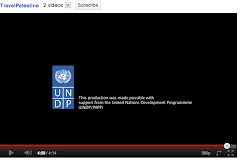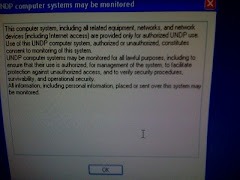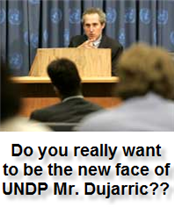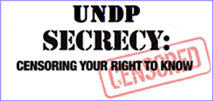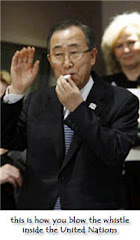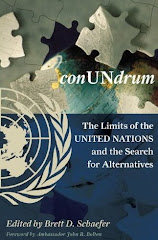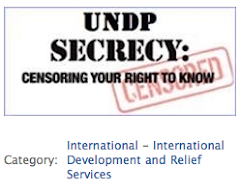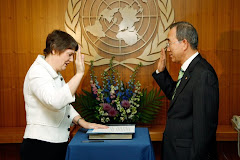 click here for story
click here for story
U.N. Investigators Depict Equality for Women Efforts Within U.N. System are a Costly Failure
By George Russell
Published April 11, 2011
| FoxNews.com
EXCLUSIVE: A month after the United Nations last summer announced the creation of a new, $500 million-a-year organization to promote equality for women in global affairs, the U.N.’s own investigators revealed that 15 years of “gender mainstreaming” efforts within the UN Secretariat have been a sweeping and costly failure.
The report, issued in August 2010, evaluates how gender mainstreaming -- the term that the U.N. uses to describe achieving equality between the sexes in all walks of life -- is being incorporated in all U.N. work to “ensure that the different needs and circumstances of women and men are identified and taken into account when policies and projects are developed and implemented.”
The evaluation carried out by the U.N. watchdog, the Office of Internal Oversight Services (OIOS), looked at 20 of the U.N.’s most important departments and offices. It found glaring deficiencies almost everywhere.
Among them:
- A fundamental lack of knowledge among U.N. staffers about the gender policy, with less than half of program managers polled saying they “always” or “mostly” believed their staff understood what gender mainstreaming is or why it should be implemented.
- An equally fundamental lack of understanding of what “gender mainstreaming” was supposed to achieve. According to the report, U.N. staffers often assess evidence of gender mainstreaming by counting the number of references to “gender,” “women,” and “girls” in documents, “rather than undertaking a considered, qualitative assessment of whether a gender perspective [meaning sensitivity to sexual equality] informs work processes.”
- “Weaknesses in leadership and accountability” in making gender equality programs work -- along with a pointed observation that U.N. Secretary General Ban Ki-Moon and his top managers “carry the responsibility for the implementation of gender mainstreaming in the United Nations Secretariat.”
- “Lack of comprehensive and systematic evidence of results.”
In other words, there was little evidence that anyone was even trying systematically to make the programs work. In the 20 departments and programs surveyed, only 12 had policies or strategies or had distributed specific guidelines on how gender mainstreaming was supposed to operate.
Click here for the full report.
Those conclusions were not for lack of U.N. efforts -- and hundreds of millions of dollars in spending -- on behalf of women’s rights, as the report documents a welter of U.N. officials, many specifically appointed to the task, running off in various directions to promote improved attitudes toward sexual equality, without necessarily indicating what they were trying to promote.
The picture painted by the document is a particular embarrassment to Secretary General Ban Ki-moon, who has made women’s rights a personal crusade since he took office in December 2006, and who orchestrated the latest U.N. agency to boost the promotion of the issue.
Ban’s own office, it appears, declined to contribute to the OIOS effort to analyze the U.N.’s gender mainstreaming effort. One reason for the lack of input may have been a simmering feud that broke into the open last year between Ban and the then-head of OIOS, Inga-Britt Ahlenius, who was about to end her mandated term as chief of the watchdog group.
In an end-of-mandate letter to Ban in July 2010, which was promptly leaked to the press, Ahlenius accused the secretary general of blocking key personnel choices, “undermining” her organization and leading a Secretariat that was “drifting into irrelevance.”
Ban denied all the charges. The OIOS report on “gender mainstreaming” was published just weeks after news of the quarrel broke.
The U.N. established its gender mainstreaming policy as a global plan of action in 1995, at the Fourth World Conference on Women in Beijing. The Beijing Platform for Action, which resulted from the conference, required nations to work toward ending discrimination against women by reforming areas such as health care and education to take greater account of women’s needs.
A host of other UN conferences and documents have emphasized the same theme.
But that only scratches the surface of the UN’s efforts, since a flock of U.N. agencies had been working in support of a female economic and social agenda for decades previously.
Four of the most important -- the Office of the Special Adviser on Gender Issues and Advancement of Women; the Division for the Advancement of Women; the United Nations Development Fund for Women; and the International Research and Training Institute for the Advancement of Women -- had a combined annual budget last year of $250 million, according to the U.N.
Those are the agencies that the UN announced in July 2010 would be merged into the new body known as the “United Nations Entity for Gender Equality and the Empowerment of Women,” or U.N. Women, effective January 2011.
The first head of the new organization is Chile’s former Socialist president, Michelle Bachelet.
The new agency got $70.2 million in start-up donations last year, and has begun fundraising for its $500 million annual budget target.
It says it will present its first strategic plan to the 41-member supervisory executive board this June. Almost as soon as it was announced, the organization drew controversy when Saudi Arabia and Libya, both countries where women have secondary status, were chosen to sit on the executive board.
One of the main functions of the new organization, according to the U.N, Women website, is to help “intergovernmental bodies” in their formulation of “policies, global standards and norms” in the women rights area. U.N. Women is especially supposed to support the U.N.’s Commission on the Status of Women --- composed of 45 U.N. member states on a rotating basis, mandated in 1946 to make recommendations on “urgent problems requiring immediate attention in the field of women’s rights.”
The commission is described as “the U.N.’s principal policy-making body” on the issue.
Presumably in executing the Council’s wishes, U.N. Women is supposed to help member states implement pro-female standards -- and hold the entire U.N. system itself “accountable for its own commitments on gender equality, including regular monitoring of system-wide progress.”
Via a U.N. inter-agency network, U.N. Women, according to its website, “helps orchestrate the efforts of 25 U.N. organizations to promote gender equality across the U.N. system.” Apparently the four organizations now blended into U.N. Women, were doing a pretty poor job, according to the OIOS findings. Among other things, the report says, there was plenty of bureaucratic action on the gender equality front, but not much coordination.
The U.N. programs surveyed all have different ideas about what the objectives of gender mainstreaming ought to be, and different ideas about how to carry out the sexual equality agenda. Only three programs surveyed actually “went beyond objectives to specify required actions for staff at each level,” the report reveals, a task it admitted was “inherently difficult.” But there were plenty of office holders claiming to be heavily involved in gender-related work.
Many U.N. programs, the report says, “had a gender unit, or adviser, and some also had specialist gender expertise at field locations.” Others had developed “a network of gender focal points, who had gender mainstreaming responsibilities in addition to their substantive work.”
Some had definite lines of accountability for what they did, and others did not. “Approaches to resourcing, capacity development, monitoring and reporting were also varied,” the report notes dryly. Just how much all that effort cost is not known. Few U.N. programs “claimed to track the human and/or financial resources associated with gender mainstreaming,” the OIOS report noted. Nor was anyone trying very hard to learn from anyone else.
“In searching for effective approaches, each program appears to be constantly reinventing initiatives,” the report notes. One outcome of the disorganized efforts: Only 45 percent of U.N. managers surveyed said they felt UN staff “always” or “mostly” understood what gender mainstreaming was, compared to 49 percent who said staff “sometimes” or “never know.”
In more general terms, the report notes, “when asked how gender mainstreaming contributed to the goal of gender equality, those interviewed often struggled to offer concrete or documented examples.”
According to OIOS, one way to remedy the deficiencies would be to shift the UN’s focus “from process to results.”
Some “common principles, tools and indicators for common tasks” would also help. So would an action plan that contained “desired outcomes and indicators,” as well as “establishing clear expectations for [U.N.] managers and staff at all levels.” Many of the OIOS recommendations appear to have been included in U.N. Women’s first 100-Day Action Plan, announced by Bachelet in February.
Among other things, it claims that the new organization “will prepare a system-wide coordination strategy on gender equality in the first half of 2011, with clear deliverables for U.N. Women and the U.N. system, to promote greater coherence in line with existing agencies’ mandates and priorities.”
Bachelet also promised to clear up some of the fog surrounding how much money the U.N. already spends on women’s equality issues, by creating a “shared resource tracking system for the U.N. system.” How long will it take to see if the new organization does any better than the constellation of organizations it has replaced?
In its report, the OIOS calls the launch of U.N. Women “an opportunity for an early re-evaluation of gender mainstreaming in the Secretariat” -- preferably within three years. Given its current projected budget, that would allow UN Women to spend at least $1.5 billion on supporting “policies, global standards and norms” for sexual equality before deciding whether the U.N. had done any better than in the past.
An important U.N. budget committee, however, has already declared its concern that the new agency’s launch plans are “overly ambitious,” and that its management, drawn from the organizations it replaces, runs the risk of being top-heavy.
George Russell is executive editor of Fox News
























